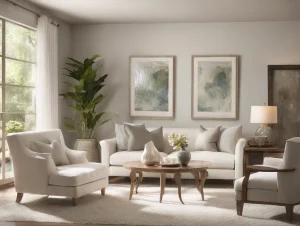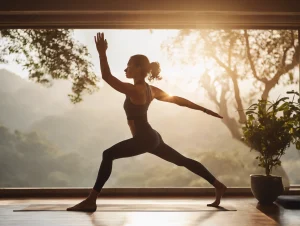The allure of blending indoor and outdoor living spaces has captivated homeowners and designers alike for years. It’s an approach that not only enhances the aesthetic appeal of a home but also maximizes the usable space, creating a harmonious environment that promotes relaxation and convenience. As a DIY enthusiast and home improvement expert, I’ve seen firsthand the transformative power of seamless indoor-outdoor living. Here, I’ve compiled a comprehensive guide to help you achieve this elegant integration in your own home.
Start with a Plan
Before diving into any project, it’s crucial to have a clear plan. Assess your current layout and identify the areas where you can merge indoor and outdoor spaces. Consider factors such as the direction of sunlight, prevailing wind patterns, and the natural flow of your home’s architecture.
Key Considerations:
- Budget: Determine how much you’re willing to spend on the project.
- Functionality: Decide how you want to use the space – for dining, lounging, entertaining, or a combination.
- Style: Choose a cohesive design theme that will tie both areas together.
Create a Visual Connection
One of the most effective ways to blend indoor and outdoor spaces is by creating a strong visual connection between them. This can be achieved through the use of large windows, glass doors, or even retractable walls. These elements allow natural light to flood into your home while providing unobstructed views of your outdoor area.
Tips for Visual Connection:
- Floor-to-Ceiling Windows: Install large windows that extend from the floor to the ceiling. This not only enhances the visual connection but also makes the space feel larger.
- Sliding Glass Doors: Opt for sliding glass doors that can be opened wide to merge the indoor and outdoor spaces seamlessly.
- Bi-Fold Doors: Consider bi-fold doors that can be folded back completely, erasing the boundary between the two areas.
Consistent Flooring
Continuity in flooring is a subtle yet powerful way to tie indoor and outdoor spaces together. Using the same or similar flooring materials creates a seamless transition that enhances the overall flow of the area.
Flooring Options:
- Porcelain Tiles: These are durable, weather-resistant, and available in a variety of styles that can complement both indoor and outdoor aesthetics.
- Concrete: A polished concrete floor can extend from inside your home to your patio, providing a sleek and modern look.
- Wood or Wood-Look Tiles: Natural wood or wood-look tiles offer warmth and can be used both indoors and outdoors for a cohesive appearance.
Outdoor Furniture and Decor
Choosing the right furniture and decor is essential for creating a seamless indoor-outdoor living space. Opt for weather-resistant furniture that matches or complements your indoor style. This ensures a harmonious look and feel, regardless of where you are in the space.
Furniture and Decor Tips:
- Matching Sets: Consider using the same or similar furniture sets for both indoor and outdoor areas.
- Durable Materials: Choose materials like teak, aluminum, or synthetic wicker that can withstand the elements.
- Cushions and Fabrics: Select outdoor cushions and fabrics that are resistant to moisture and UV rays but still echo the comfort and style of your indoor furnishings.
Greenery and Natural Elements
Incorporating plants and natural elements can blur the lines between indoor and outdoor spaces. Indoor plants can create a sense of continuity and bring a touch of nature inside, while outdoor landscaping can be designed to complement your interior decor.
Greenery Tips:
- Indoor Plants: Use potted plants, hanging gardens, or vertical planters to bring greenery into your indoor space.
- Outdoor Landscaping: Design your garden or patio with plants and features that reflect your indoor style.
- Natural Materials: Incorporate natural materials like stone, wood, and water features to create a cohesive look.
Lighting
Proper lighting is crucial for creating a seamless indoor-outdoor living experience. It enhances the ambiance and functionality of the space, allowing you to enjoy it at any time of day or night.
Lighting Tips:
- Ambient Lighting: Use ambient lighting, such as string lights, lanterns, or garden lights, to create a warm and inviting atmosphere outdoors.
- Task Lighting: Ensure there is adequate task lighting for areas where you need it, such as outdoor kitchens or dining areas.
- Consistency: Use similar lighting fixtures and styles both indoors and outdoors to maintain continuity.
Outdoor Kitchen and Dining
An outdoor kitchen and dining area can significantly enhance your indoor-outdoor living experience. It allows you to cook and dine al fresco, making the most of pleasant weather and creating a unique entertaining space.
Outdoor Kitchen Tips:
- Grill and Appliances: Invest in a high-quality grill and consider adding other appliances such as a refrigerator, sink, and storage cabinets.
- Counter Space: Ensure there is ample counter space for food preparation and serving.
- Shade and Shelter: Provide shade with a pergola, umbrella, or retractable awning to make the area comfortable in various weather conditions.
Fire Features
Adding a fire feature, such as a fireplace or fire pit, can create a focal point and enhance the ambiance of your outdoor space. It also extends the usability of the area into cooler months.
Fire Feature Tips:
- Location: Place the fire feature in a central location where it can be enjoyed from both indoor and outdoor areas.
- Style: Choose a fire feature that complements your overall design theme, whether it’s modern, rustic, or traditional.
- Safety: Ensure the fire feature is installed safely with proper ventilation and clearance from flammable materials.
Technology Integration
Incorporating technology can enhance the functionality and enjoyment of your indoor-outdoor living space. From outdoor speakers to smart lighting, there are various ways to integrate technology seamlessly.
Technology Tips:
- Outdoor Speakers: Install weather-resistant speakers to enjoy music or entertainment outdoors.
- Smart Lighting: Use smart lighting systems that can be controlled remotely to adjust the ambiance and ensure energy efficiency.
- Wi-Fi: Extend your Wi-Fi coverage to outdoor areas for seamless connectivity.
Maintain and Personalize
Finally, regular maintenance and personalization are key to keeping your indoor-outdoor living space looking and feeling its best. Clean and maintain furniture, plants, and fixtures regularly, and don’t be afraid to add personal touches that reflect your style and personality.
Maintenance Tips:
- Regular Cleaning: Clean surfaces, furniture, and fixtures regularly to prevent dirt and wear.
- Seasonal Care: Adjust your maintenance routine according to the season, such as protecting plants in winter or cleaning outdoor grills in spring.
- Personal Touches: Add decor items, artwork, or accessories that reflect your taste and make the space uniquely yours.
In conclusion, creating a seamless indoor-outdoor living space is an achievable and rewarding project that can transform your home and enhance your lifestyle. By following these tips and considering factors such as visual connection, consistent flooring, furniture, greenery, lighting, and technology, you can create a harmonious and functional environment that you and your family will enjoy for years to come. Happy DIY-ing!








